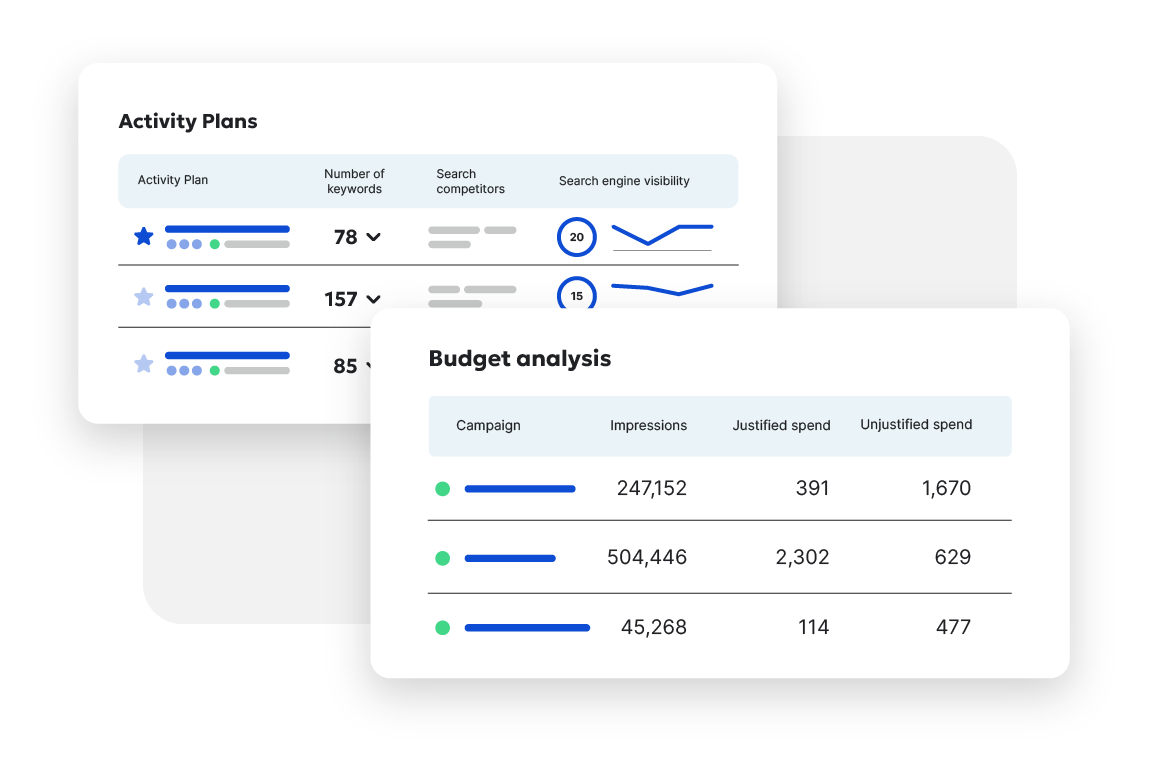Each year, millions of student-hopefuls apply to higher education institutions. And with thousands of options to choose from, selecting a university with the best programs and opportunities to meet their goals can be a challenge. This is where search comes into play.
Until recently, it wasn’t necessarily commonplace for universities to have a search strategy. But both students and parents rated college websites as the most influential and reliable recruitment resource when selecting a university, according to the 2019 E-Expectations Report from Ruffalo Noel Levitz, OmniUpdate, CollegeWeekLive, and NRCCUA.
As universities feel the competition increase, more are pursuing organic and paid search tactics and strategies.
What is a search strategy?
A search strategy is when you use both organic search engine optimization (SEO) and pay-per-click (PPC) together to achieve your website goals.
SEO: Organic search
When prospective students or parents search for programs you offer or other information about your institution, you want them to see the right pages in their search results. SEO is the process of optimizing your website so your audience can easily find it when searching for your university or relevant terms. One of the best aspects of SEO is that it doesn’t require you to pay when users click your link.
PPC: Paid search
PPC is a type of online advertising where an organization pays a fee each time its ads are clicked. Universities, like other organizations, now pay to have their ads displayed alongside organic search results. Paid search results usually appear above organic results with a small “sponsored” disclaimer.
Both these strategies are valuable and can be combined to promote your institution.
Should higher education have a search strategy?
Yes! Search engines are the most popular way to find information—and this is especially true when researching potential educational institutions. By investing in both SEO and PPC, universities can expand their visibility, attract new web traffic, cultivate prestige, and even increase enrollment.
As a university, where do you start? There’s a lot to learn about these multidimensional marketing strategies, but we’ve narrowed it down to some best practices and actionable advice to help you dive into your search journey.
SEO best practices for higher education

SEO is more of a marathon than a sprint. However, if done right, SEO can help your university possess a strong, long-standing search engine presence and create new traffic. Below are five best practices to start your SEO strategy off on the right foot:
1. Start with an SEO audit
As SEO is an organic, long-term strategy, it takes time for content to rank well in keyword searches. So, to start, identify which keywords your site already ranks well for and which keywords you want to rank for but don’t.
Once you’ve audited your site’s current performance, you can further optimize well-ranking pages and come up with strategies to optimize the poorer ranking pages with more suitable keywords.
2. Improve user experience
Before worrying about keywords in your university’s web content, there are some basic, technical aspects related to your site’s user experience that also affect SEO and rank factor:
- Test and improve your page speed: Page speed affects both your rank factor and bounce rate, due to modern expectations of load speeds. Certain digital tools, like Siteimprove Performance, can test your site speed and provide suggestions for improving page load time.
- Make it mobile friendly: Beyond the fact that 71% of students view university websites using mobile devices, Google prioritizes mobile friendly pages. Opt for a responsive site design that automatically adapts to device size. Then, ensure all your pages, especially legacy pages, are updated to that design.
- Double-check duplicate content: Universities often have a lot of duplicate content due to various departments having their own pages, blogs, or digital publications. But search engines penalize sites that have duplicate content. To evade such penalization, use a digital tool to identify and eliminate duplicate pages.
- Submit a sitemap: Once you’ve finished optimizing your site, create and submit a sitemap to Google Search Console to guide Google bots toward indexing and prioritizing your site pages. Simply follow Google’s instructions for building and submitting a site map.
3. Let your value propositions lead your keyword research
To develop your keyword strategy, put your value propositions at the forefront when brainstorming targeted keywords. Ask yourself questions like, does my university specialize in a specific degree program, or offer full programs online?
Next, use a tool like Siteimprove Keyword Suggestions to brainstorm related words to your value propositions. These tools will show related keywords, long-tail searches (longer and more specific searches), and questions users ask that are linked to your core keywords.
Then, group related questions and terms together to create keyword clusters. Doing this ensures your keywords are connected to the unique offerings of your university, while still being relevant to student and parent searches.
If you’re just starting your keyword research process, we recommend targeting long-tail keywords, as they are generally the easiest way to target very specific audiences and get the right organic traffic to your site.
4. Optimize content accordingly
Prioritize optimizing the content on your main pages first, like department or program pages, and then venture to the less vital pages, like student organization blogs.
Though it may seem obvious to distribute your keywords naturally throughout your content, it’s easy to overdo it by stuffing in as many keywords as possible. This keyword cramming not only sacrifices the quality of your content, it’s actually bad for your SEO.
So, to make sure you’re not hurting your SEO, here are the key areas your target keywords should appear:
- In the page title or H1
- Occasionally in the body of texts
- In the page’s meta description and title
5. Create quality links
Link building is equally as important as keyword optimization for a university’s SEO success. Focus on internal linking by inserting links into your content to connect your related pages. Be sure to help search engines understand what your content is about by making the links’ anchor texts descriptive.
Then, start building external links from other high-quality sites to connect your institution and its educational programs to high-quality directories. Don’t forget to seek out links from other prestigious educational institutions. Or, if your university is research-oriented, focus linking your newly published studies located on high authority sites to your respective department pages.
PPC best practices for higher education

To bolster your organic SEO, your university can employ a complementary PPC strategy. PPC is particularly effective in providing instant visibility in search results, especially while you develop your organic SEO. You can also use PPC to target conversation-related keywords people search for at important moments in their school decision-making process.
To maximize PPC, below are five best practices:
1. Don’t bid on “branded” terms
Bidding on “branded” terms means that you bid on your university name. While this is effective for e-commerce businesses attempting to attract traffic away from competitors, it’s not well spent money for universities.
Why? Other universities are not likely bidding on your university name. You can quickly check if this is the case by searching for your university name in an incognito browser. (If you see paid ads for other universities, then you should consider bidding on your university name).
Most people searching for your institution by name are likely current students, followed by faculty or staff searching for the university as a quick way to navigate to your homepage. This means when your ad appears and a current student or faculty member clicks on it, you still have to pay for the conversion.
2. Keep keyword relevance and intent in mind
If your university’s goal is to ensure your ads appear for searchers interested in applying for an educational program, you’ll want to target keywords that reflect the right period of their student journey. For example, consider one of your degree programs, like an undergraduate degree in nutrition and dietetics. You could target “nutrition and dietetics”, but then your ads might appear for people watching their weight for summer.
To target the right audience, remember to use specific keywords like “nutrition and dietetics” + “bachelor’s degree”. The more specific and relevant your target keywords, the more likely they’ll reach relevant users at the right moment.
Tools like Siteimprove Ads or Google Ads can provide information about average monthly searches, how competitive a keyword is, and more.
3. Consider the journey beyond your ads
Attracting traffic to your university’s site is important, but if you want PPC ads to lead prospective students to apply to your programs, consider the phase in their student journey path after clicking on your ad. The ad shouldn’t link to a generic landing page or the department’s homepage. Instead, create a unique landing page that highlights the program based on the interests and needs of those potential students.
The reason your university pays for clicks is to have its web content convince prospective students to apply. So, offer them content that provides a clear overview of the program and a direct call-to-action, like inquiring more about the program.
4. Test and tailor your ad copy
It may seem simple but changing up your ad copy can hugely impact click-through rates. Universities using phrases like “no application fee required” and “GRE not required” in their ads are positioning their unique selling points to stand out and drive clicks.
No matter what information you choose to highlight in your ads, test it on your audience. Some digital analytics tools create ad variations by making changes to headlines, calls-to-action, or ad extensions. And some tools automate the rotation of these variations so it’s easy to identify the most effective ad copy combination for increasing clicks.
5. Perfecting your strategy based on performance
Speaking of testing performance, it should be part of your organizational culture to continuously check in with your PPC campaigns to see what keywords, ad copy, and bid strategies do a better job of helping reach your goals.
If you use a tool like Siteimprove Ads, you’ll see that certain keywords are highly competitive and very expensive, such as MBA-related keywords. This may encourage you to bid more on related keywords that help meet your search strategy goals. You can then reduce investments in expensive keywords that don’t deliver value.
Using a holistic search strategy
A holistic search strategy is the best way to bring together your target audience and your key marketing messages. As search engines continue to dominate decision-making, recruiting prospective students online is a channel that cannot be neglected. By prioritizing your search engine efforts, you’re increasing the probability of student engagement and applications.
These recommendations and best practices for organic SEO and PPC strategies will enable you to run a successful search marketing campaign. And as your efforts deliver results, it becomes easier to gain more organizational buy-in for investing in optimization and automation tools for even greater ROI.

Ready to improve your Search Engine Optimization?
Siteimprove SEO is an all-in-one Enterprise SEO tool that can help you achieve your digital potential.
Schedule a demo
